Abstract
Location detection is studied for many scenarios, such as pointing out the flaws in multiprocessors, invaders in buildings and facilities, and utilizing wireless sensor networks for monitoring environmental processes. The system or structure can be illustrated as a graph in each of these applications. Sensors strategically placed at a subset of vertices can determine and identify irregularities within the network. The open locating-dominating set S of a graph is the set of vertices that dominates G, and for any V(G) is satisfied. The set S is called the OLD-set of G. The cardinality of the set S is called open locating-dominating number and denoted by . In this paper, we computed exact values of the prism and prism-related graphs, and also the exact values of convex polytopes of and . The upper bound is determined for other classes of convex polytopes. The graphs considered here are well-known from the literature.
Keywords:
open locating-domination number; cycle graphs; prism graphs; convex polytopes; exact values; upper bounds MSC:
05C69; 05C90
1. Introduction and Preliminaries
For an undirected graph , and for any vertex , the open and closed neighborhoods are written as and . The open locating-dominating set S of G is the set of vertices that dominates G, and for any vertices, say such that is satisfied. The set S will be denoted as an OLD-set and the least number of elements in such a set will be denoted as .
Location detection problems have been considered for several applications, including detecting faults in multiprocessors, contaminants in standard utilities, invaders in buildings and amenities, and environmental monitoring employing wireless sensor networks. The system or framework can be modeled as a graph in each of these applications. Sensors strategically placed at a subset of vertices can determine and identify irregularities in the network. Such sensors can be expensive, and therefore, it is vital to reduce the size of the OLD-set. If the detector can distinguish an invader at , without the ability of detecting at u, then we consider an open locating-dominating set, as studied in [1,2,3,4,5]. If a detection device can resolve an intruder in the closed neighborhood of N[u] but cannot locate the location, then we are interested in the identifying code, as studied in [6]. The identifying code I is a vertex subset of which dominates G, and for any , the relation holds.
The following result obtained by [7,8] presents the lower bound for the open locating-dominating number.
Theorem 1
([7,8]). Let G be a graph of order n and maximum degree . If G has an OLD-set, then obeys
This paper continues the study of domination parameters in different rotationally-symmetric graphs. The binary locating-dominating number denoted as , which is also known as the locating-dominating number, was studied in [9,10] among different classes of convex polytopes. The open locating-dominating number was studied in [11]. In this paper, motivated by these results, we study the OLD-set with minimum cardinality and values. The graphs considered in this paper are already known from the literature, and they are rotationally-symmetric. The paper is organized as follows. In Section 2, we give an improved result for the OLD-set with minimum cardinality and values for cycle graphs. The result is later employed to determine the upper bounds. In Section 3, the exact values are calculated for the prism graph and the prism-related graph . Moreover, in Section 4, the exact values are presented for the graphs of convex polytopes , and . Section 5 comprises the upper bounds for the classes of convex polytopes , , , , , and the web graph , respectively. Section 6 provides the conclusions.
2. Main Results
Cycle Graphs
The graphs considered in this paper are generated from cycle graphs. So, we provide an improved result for the open locating-dominating number of cycle graphs. The cycle graphs are 2-regular graphs. Mathematically, the vertex set is
The edge set is
Lemma 1.
For , we have
Proof.


To show the upper bound, we define the set S.
The following three cases are presented.
Case 1: When , and ; let .
Case 2: When , and ; let .
Case 3: When , and ; let .
Table 1 shows that for any vertex the corresponding are non-empty and mutually distinct. Thus, we have

Table 1.
Open locating-dominating vertices in .
We obtain that
The authors of [12] have shown the OLD-set for the cycle graph and the OLD-values, . For , they proved that the set . Now, let us consider the cycle graph . Let the set . Table 2 clearly shows that . In general, it can be written as , thus proving that the cardinality of open locating-dominating values for .

Table 2.
Open locating-dominating vertices in .
□
The following conjecture is presented.
Conjecture 1.
3. Exact Values
3.1. The Graph of Prism
The prism is a 3-regular graph, as seen in Figure 1. It was studied in [13], and recently, this graph has been studied for the mixed metric dimension in [14]. The prism graph is generated by the Cartesian product of a cycle graph and a path graph . The outer cycle comprises vertices and an inner cycle .
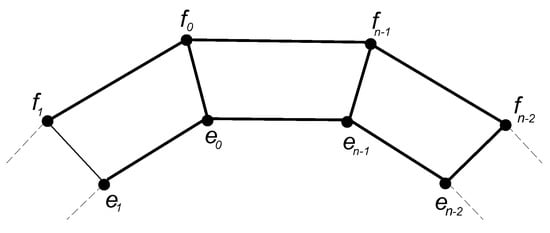
Figure 1.
The graph of .
The vertex set of is
The edge set of is
Theorem 2.
For , the is
Proof.
The prism graph is a 3-regular graph. So, by Theorem 1, we have
Let . It can be seen that all the intersections ; are non-empty and distinct. Since the set S is an open locating-dominating set of the prism graph , we have . Therefore, it can be deduced that . Keeping in mind the fact that we have , it is proven that . □
3.2. The Prism Related Graph
The plane graph , as seen in Figure 2, has been recently studied in [15]. It is an extension of the prism graph . The is constructed. It is obtained by inserting a new vertex in the central vertices and of the external cycle with the vertex by joining the two vertices and for . For the sake of simplicity, . The set of vertices , and , are called internal, central and external vertices. The vertex set of is
and the edge set of is
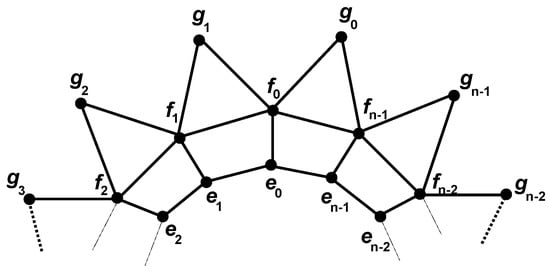
Figure 2.
The graph of .
Theorem 3.
For , the is given as
Proof.
The plane graph is the graph with the maximum degree five. Then, by Theorem 1, we have
Let . It can be clearly seen that , , are non-empty and distinct. Since the set S is an open locating-dominating set of the prism-related graph , we have . Therefore, it can be deduced that . Keeping in mind the fact that we have , it is proven that . □
4. Exact Values of Convex Polytopes
4.1. The Graph of Convex Polytopes
The labeling problem of (), the graph associated with a family of convex polytopes, was studied by Bača [16] (). It is shown in Figure 3.

Figure 3.
The graph of convex polytope .
Miller et al. [17] studied different variations of by describing its dual, and the dual G represented as , for a given planar graph. The construction of G is performed by adding a vertex in the internal face of G. If their corresponding faces share an edge, then it should be joined. This new polytope is represented as . The family of graphs can be generated from the graph of when a layer of hexagons is added between the two pentagonal layers. The graph of can be viewed in Figure 4.
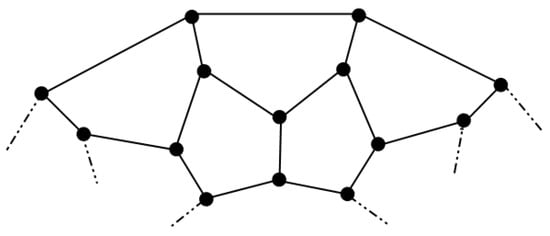
Figure 4.
The graph of convex polytope .
The graph of a convex polytope , as shown in Figure 5, consists of 5-sided faces, n 6-sided faces, and n-sided faces, as studied in Miller et al. [17]. The vertex set of is
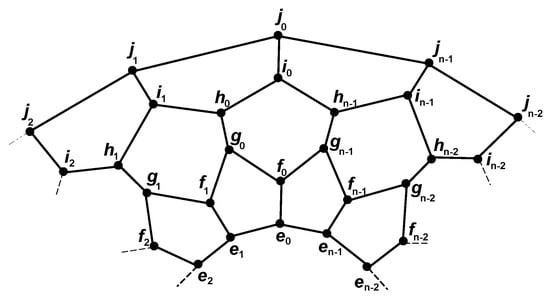
Figure 5.
The graph of convex polytope .
The edge set of is
Theorem 4.
For , we have
Proof.

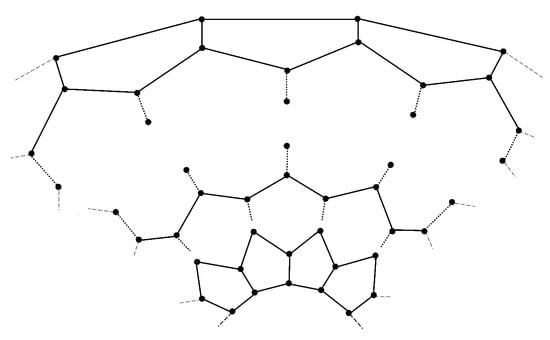
The graph of the convex polytope is a 3-regular graph of degree 3. Then, by Theorem 1, we have .
Let .
The Table 3 clearly shows that the intersections are non-empty and distinct.

Table 3.
Open locating-dominating vertices in .
So, the set S is an OLD-set of . So, , and therefore, . On the other hand, . So, from all the above facts, it follows that .
The extension of the graph yields more families of regular graphs of convex polytopes by preserving the symmetric relation as shown in the Figure 6. □

Figure 6.
Extension of the graph .
4.2. The Graph of Convex Polytope
Now, we study further variations of and the open locating-domination number for this family of graphs. In a similar fashion to Miller et al. [17], is obtained by adding an extra layer of hexagons in between the lower hexagonal layer and the outer pentagonal layer, as seen in Figure 7. The graph of consists of pentagonal and hexagonal faces and also a pair of n-gonal faces.
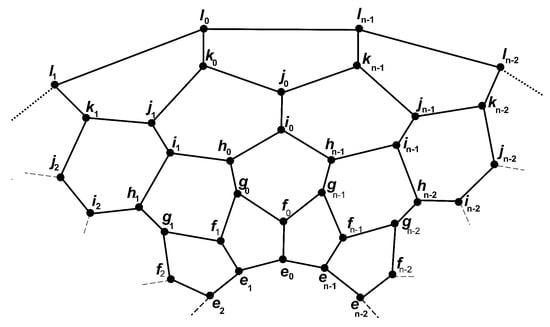
Figure 7.
The graph of convex polytope .
The vertex set is
The edge set is
Now, we will validate the vertex and the edge set of the graph by fixing , and draw the graph .
The vertex set of is
The edge set of is
The graph of the convex polytope is constructed by using the vertex and edge sets as shown in Figure 8.
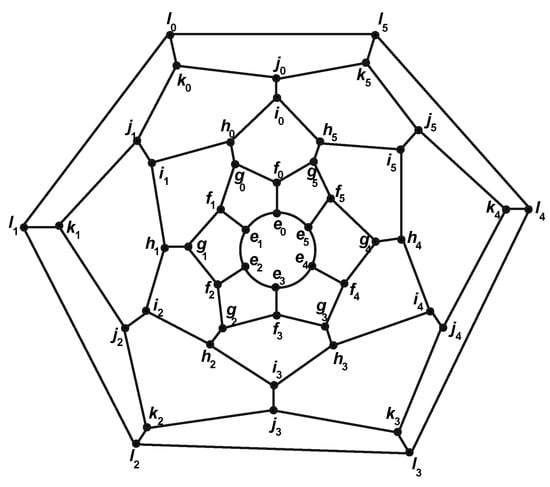
Figure 8.
The graph of convex polytope .
Theorem 5.
For , we have
Proof.

The graph of the convex polytope is a 3-regular graph of degree 3. Then, by Theorem 1, we have .
Let .
The Table 4 clearly shows that the intersections are non-empty and distinct.

Table 4.
Open locating-dominating vertices in .
So, the set S is an open locating-dominating set of . So, , and therefore, . On the other hand, . From all these above facts, it follows that . □
Remark.
Further extension of the graph , as seen inFigure 6, yields more classes of regular convex polytopes, and we claim that all these families of convex polytopes have exact values for the open locating-dominating number.
5. Upper Bounds
5.1. The Graph of Convex Polytope
The graph of the convex polytope is composed of trigonal, 4-gonal and a pair of n-sided faces. A recent study for this class of convex polytopes has been carried out in [18], see Figure 9. Now, the vertex set of is
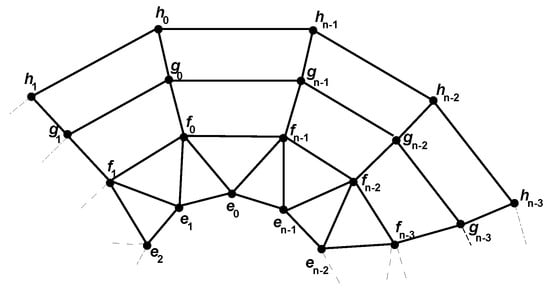
Figure 9.
The graph of convex polytope .
The edge set of is
An upper bound is presented for .
Theorem 6.
For , for the graph of the convex polytope , we have
Proof.

We consider three cases.
Case 1: When , and . Let .
Case 2: When , and . Let .
Case 3: When , and . Let .
The Table 5 clearly shows that in all these cases the intersections are non-empty and distinct. □

Table 5.
Open locating-dominating vertices in .
5.2. The Graph of Convex Polytope
The graph of the convex polytope consists of 3-sided faces, n 4-sided faces, n 6-sided faces, trigonal faces, and a pair of n-sided faces, as studied [19].The notation for this class of convex polytopes is and, to avoid ambiguity, we use , see Figure 10. Mathematically, the vertex set of is
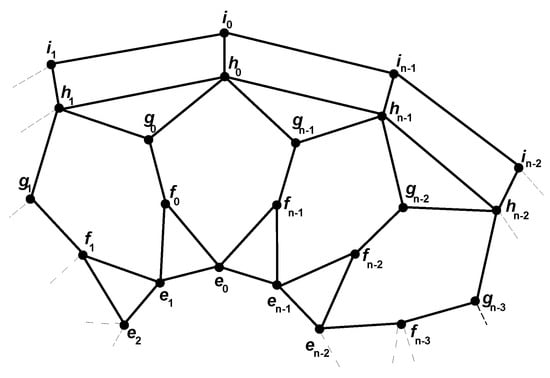
Figure 10.
The graph of convex polytope .
The edge set is
Theorem 7.
For , the graph of the convex polytope ,
Proof.

Let .
It can be clearly seen from Table 6 that all the intersections of vertices with the set S are non-empty and distinct. So, , and thus, . Therefore, we obtain that . □

Table 6.
Open locating-dominating vertices in .
Theorem 8.
(i) For , the graph of convex polytopes ,
(ii) For , the web graph ,
(iii) For , the graph of convex polytopes ,
(iv) For , the graph of convex polytopes ,
Proof.
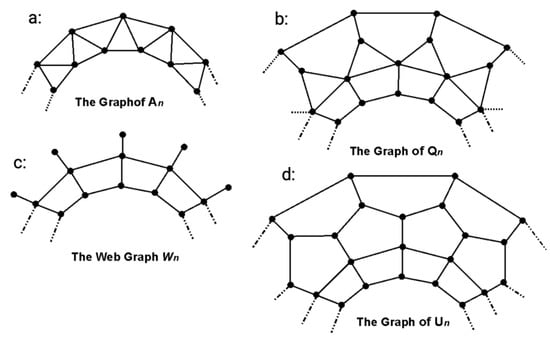
The proofs for the graphs of , , , and are similar. For the structural properties of these graphs, see Figure 11. □

Figure 11.
(a) The graph of convex polytope . (b) The graph of convex polytope . (c) The web graph . (d) The graph of convex polytope .
6. Conclusions
In this paper, we improved the result for the OLD-set and the value of cycle graphs when . The exact values of for the graphs of prism , and prism-related graphs are attained. Furthermore, the exact values are also attained for the graphs of the convex polytopes and . The upper bounds are computed for the graphs of the convex polytopes , , , , and and also for the web graph .
Future research can focus on the different invariants of domination-related parameters for the classes of convex polytopes. The open locating-dominating set can be considered for more challenging classes of graphs.
Funding
The work of Hassan Raza is supported by the post-doctoral funding of the University of Shanghai for Science and Technology under Grant No. 5B-19-303-001 and 10-20-303-302.
Institutional Review Board Statement
Not applicable.
Informed Consent Statement
Not applicable.
Data Availability Statement
The data used to support the findings of this study are included within the article.
Conflicts of Interest
The author declares no conflict of interest.
References
- Cappelle, M.R.; Coelho, E.M.; Foulds, L.R.; Longo, H.J. Open-independent, Open-locating-dominating Sets in Complementary Prism Graphs. Electron. Notes Theor. Comput. Sci. 2019, 346, 253–264. [Google Scholar] [CrossRef]
- Seo, S.J.; Slater, P.J. Open-independent, open-locating-dominating sets. Electron. J. Graph Theor. Appl. 2017, 5, 179–193. [Google Scholar] [CrossRef]
- Seo, S.J.; Slater, P.J. Open neighborhood locating-dominating in trees. Discret. Appl. Math. 2011, 159, 484–489. [Google Scholar] [CrossRef]
- Seo, S.J.; Slater, P.J. Open Locating-Dominating Interpolation for Trees. Congressus Numerantium 2013, 215, 145–152. [Google Scholar]
- Slater, P.J. Dominating and reference sets in a graph. J. Math. Phys. Sci. 1988, 22, 445–455. [Google Scholar]
- Karpovsky, M.G.; Krishnendu, C.; Lev, B.L. On a new class of codes for identifying vertices in graphs. IEEE Trans. Inf. Theor. 1998, 44, 599–611. [Google Scholar] [CrossRef]
- Seo, S.J.; Slater, P.J. Open neighborhood locating dominating sets. Australas. J. Combinat. 2010, 46, 109–120. [Google Scholar]
- Chellali, M.; Rad, N.J.; Seo, S.J.; Slater, P.J. On open neighborhood locating-dominating in graphs. Electron. J. Graph Theor. Appl. (EJGTA) 2014, 2, 87–98. [Google Scholar] [CrossRef]
- Raza, H.; Hayat, S.; Pan, X.F. Binary locating-dominating sets in rotationally-symmetric convex polytopes. Symmetry 2018, 10, 727. [Google Scholar] [CrossRef]
- Simić, A.; Bogdanović, M.; Milošević, J. The binary locating-dominating number of some convex polytopes. Mathematica Contemporanea 2017, 13, 367–377. [Google Scholar] [CrossRef]
- Savič, A.; Maksimovič, Z.; Bogdanovič, M. The open-locating-dominating number of some convex polytopes. Filomat 2018, 32, 635–642. [Google Scholar] [CrossRef]
- Argiroffo, G.; Bianchi, S.; Lucarini, Y.; Wagler, A. The identifying code, the locating-dominating, the open locating-dominating and the locating total-dominating problems under some graph operations. Electron. Notes Theor. Comput. Sci. 2019, 346, 135–145. [Google Scholar] [CrossRef]
- Gallian, J.A. Dynamic Survey DS6: Graph Labeling. Electron. J. Comb. 2007, DS 6, 1–58. [Google Scholar]
- Raza, H.; Jia, B.; Liu, Q.S. On Mixed Metric Dimension of Rotationally Symmetric Graphs. IEEE Access 2019, 8, 11560–11569. [Google Scholar] [CrossRef]
- Zhang, Y.; Gao, S. On the edge metric dimension of convex polytopes and its related graphs. J. Combinat. Optim. 2020, 39, 334–350. [Google Scholar] [CrossRef]
- Bača, M. Face anti-magic labelings of convex polytopes. Utilitas Math. 1999, 55, 221–226. [Google Scholar]
- Miller, M.; Bača, M.; MacDougall, J.A. Vertex-magic total labeling of generalized Petersen graphs and convex polytopes. J. Combin. Math. Combin. Comput. 2006, 59, 89–99. [Google Scholar]
- Raza, H.; Hayat, S.; Pan, X.F. On the fault-tolerant metric dimension of convex polytopes. Appl. Math. Comput. 2018, 339, 172–185. [Google Scholar] [CrossRef]
- Malik, M.; Aslam, M.S. On the metric dimension of two families of convex polytopes. Afrika Matematika 2016, 27, 229–238. [Google Scholar] [CrossRef]
Publisher’s Note: MDPI stays neutral with regard to jurisdictional claims in published maps and institutional affiliations. |
© 2021 by the author. Licensee MDPI, Basel, Switzerland. This article is an open access article distributed under the terms and conditions of the Creative Commons Attribution (CC BY) license (https://creativecommons.org/licenses/by/4.0/).